PurposeCommand or Action
Exits role configuration mode.switch(config-role)# end
Step 8
Displays the user role configuration.(Optional) switch# show role
Step 9
Saves the change persistently through reboots
and restarts by copying the running
configuration to the startup configuration.
(Optional) switch# copy running-config
startup-config
Step 10
Example
This example shows how to create user roles and specify rules:
switch# configure terminal
switch(config)# role name UserA
switch(config-role)# rule deny command clear users
switch(config-role)# rule deny read-write
switch(config-role)# description This role does not allow users to use clear commands
switch(config-role)# end
switch(config)# show role
Creating Feature Groups
Procedure
PurposeCommand or Action
Enters global configuration mode.switch# configure terminal
Step 1
Specifies a user role feature group and enters
role feature group configuration mode.
switch(config) # role feature-group
group-name
Step 2
The group-name is a case-sensitive,
alphanumeric character string with a maximum
of 32 characters.
Exits global configuration mode.switch(config) # exit
Step 3
Displays the role feature group configuration.(Optional) switch# show role feature-group
Step 4
Saves the change persistently through reboots
and restarts by copying the running
configuration to the startup configuration.
(Optional) switch# copy running-config
startup-config
Step 5
Example
This example shows how to create a feature group:
switch# configure terminal
switch(config) # role feature-group group1
switch(config) # exit
switch# show role feature-group
Cisco Nexus 3548 Switch NX-OS System Management Configuration Guide, Release 7.x
207
Configuring User Accounts and RBAC
Creating Feature Groups

